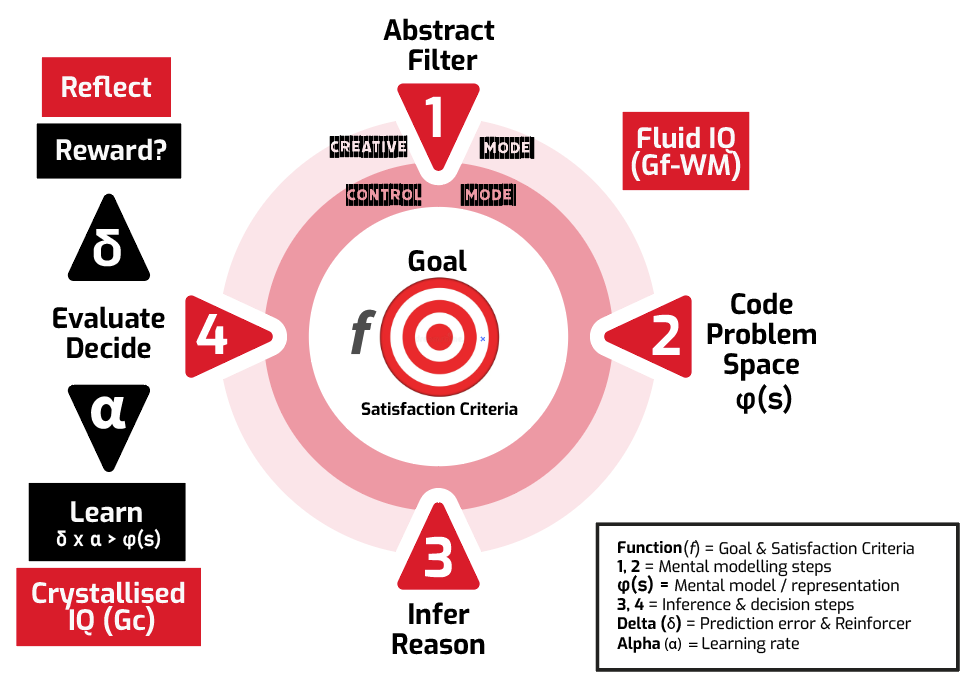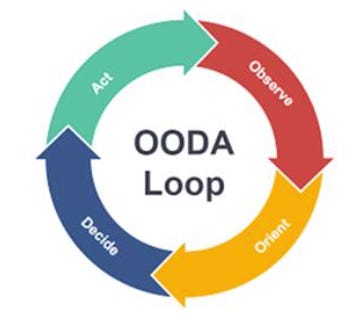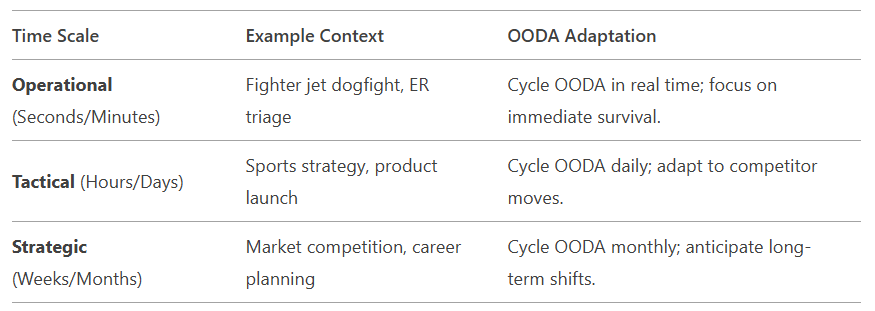Cognitive Speed: Outpacing Chaos with the OODA Loop.
Learn to think and act faster than uncertainty unfolds by mastering the Observe-Orient-Decide-Act (OODA) Loop.
The OODA Loop Mindware
Purpose: Train rapid Observe-Orient-Decide-Act cycles to outpace adversaries in dynamic, competitive environments. Real-time 'decision-dominance' with iterative adaptation.
Primary Double Loop Focus
The primary focus of the OODA Loop in terms of the G Double Loop is on the Control Loop (LTD-Driven). In adversarial, high-pressure contexts, the emphasis is on rapid error correction and convergent refinement—using prediction error (δ) to fine-tune mental models and drive efficient, decisive actions (Observe, Orient, Decide, Act). While the Creative Loop is important for generating novel hypotheses and refreshing mental models when things exceed expectations, the operational mandate of the OODA Loop is to quickly prune away ineffective approaches and maintain a tight, error-correcting cycle that outpaces an opponent’s responses.
Domain: Adversarial/competitive contexts (e.g., combat, competitive markets, sport).
🛩️ Life is a Dogfight!
In a fighter jet, milliseconds decide survival:
🎯 An enemy locks onto your position.
💥 A missile streaks toward you.
🔄 Your opponent is cycling their own OODA loop.
The OODA loop isn’t just a decision-making tool - it’s a 'weapon'. By cycling faster than your opponent, you disrupt their ability to act, forcing them into reactive, defensive postures. This is the essence of decision dominance.
The military strategist who developed the OODA strategy speaks of folding an opponent back inside himself by operating inside his observation-orientation-decision-action (OODA) loop. This can be accomplished by “tightening” friendly OODA loops and/or “loosening” enemy OODA loops. Thus, the key to winning in conflict lies in establishing a relative advantage over one’s enemy in terms of both OODA loop speed and accuracy.
And the OODA loop isn’t confined to fighter jets. Whether you’re outmaneuvering business competitors, a surgeon responding to a crisis, or an athlete adapting mid-game, the same principles apply: outthink, outpace and outmaneuver.
🔄 What is the OODA Loop?
A real-time cognitive engine for outmaneuvering adversaries:
👀 Observe: Gather critical data ("Enemy jet at 3 o’clock, closing fast")
🧠 Orient: Interpret using mental models ("Is this a feint or attack? Check radar and wingman position")
✅ Decide: Choose action ("Break left, deploy flares, and climb")
🏃 Act: Execute ("Pull 7G turn, evade missile")
Speed is survival: The goal is to cycle faster than your opponent can react.
The OODA principle: "Get inside their loop." ⚡
🎯 Why OODA Changes Everything
In real-time, adversarial contexts, hesitation can be destructive to you. OODA turns chaos into control:
In addition to rapid cycling, embracing a creative mode of mental flexibility is crucial. As John Boyd famously said:
“You gotta challenge all assumptions. If you don’t, what is doctrine on day one becomes dogma forever after.”
This reminder encourages you to relentlessly question and refine your mental models - especially during the Orient phase (corresponding to abstraction and mental modeling in the G Double Loop - ensuring that established doctrines never ossify into inflexible dogma. By continuously challenging assumptions, your OODA cycle remains dynamic and adaptive, empowering you to outthink evolving threats with innovative responses.
⚡ The α Advantage: Learning Faster Than Your Opponent
Your learning rate (α) determines how quickly you convert outcomes into better loops:
High α = Aggressive adaptation ("Missile evaded? Update evasion tactics immediately")
Low α = Conservative refinement ("Review engagement post-mission")
Control Loop Trigger: Delayed decisions → Shorten phases by 20%.
Prompt: "Which phase (Observe/Orient/Decide/Act) is your bottleneck?"
💥 OODA Across Time Scales
While Boyd’s OODA loop was designed for real-time, operational contexts, its principles can be extended to tactical and strategic time scales:
Example: Market Competition
👀 Observe: Competitor launches a new product.
🧠 Orient: Analyse their strategy using SWOT (Unit 9) and Pareto (Unit 8).
✅ Decide: Adjust pricing and marketing campaigns.
🏃 Act: Roll out changes within 48 hours.
Result: Competitor forced into reactive mode; you regain market initiative.
🛑 Common Pitfalls (and OODA Fixes)
🏆 Mastering the Loop
OODA isn’t about being right - it’s about being less wrong faster. By training your loops, you gain:
✨ Decision Dominance: Force opponents into reactive postures.
⏳ Temporal Advantage: Outpace adversaries’ decision cycles.
🧠 Cognitive Resilience: Thrive where others freeze.
Key Insight: Time Scales and Adversarial Thinking
The OODA loop’s power lies in its universality:
Operational: Outmaneuver opponents in real time.
Tactical: Adapt faster than competitors in mid-term scenarios.
Strategic: Anticipate and shape long-term competitive landscapes.
By mastering OODA across time scales, you gain a unified framework for dominating uncertainty, whether in a dogfight, a boardroom, or your personal life.
Example: Self-Defense Engagement (Getting Inside Their Loop)
👀 Observe:
Situation: You’re walking home at night and notice someone following you closely.
Data: The person is matching your pace, glancing around furtively, and closing the distance.
🧠 Orient:
Mental Models: Assess the environment (e.g., well-lit areas, nearby exits), your physical state (e.g., fatigue, readiness), and the potential threat level (e.g., body language, weapons).
Reframe: Challenge assumptions -is this person truly a threat, or are they just walking the same route? If a threat, what’s their likely intent (e.g., robbery, assault)?
Adversary’s Loop: Predict their next move. Are they waiting for you to enter a secluded area? Are they testing your awareness?
✅ Decide:
Options:
Cross the street to create distance.
Head toward a crowded area or enter a store.
Prepare to defend yourself if necessary.
Choice: Cross the street and increase your pace toward a well-lit, populated area.
🏃 Act:
Execution: Move decisively across the street, maintain awareness of the follower’s actions, and position yourself near other people.
Disruption: By changing your path and moving toward safety, you force the follower to reassess their plan.
How You Get Inside Their Loop
Speed: You act before the follower can finalise their plan. While they’re still Observing your behavior, you’ve already Acted, disrupting their cycle.
Unpredictability: By crossing the street and moving toward a crowded area, you introduce uncertainty into their Orient phase. They must now decide whether to continue following (increasing their risk of exposure) or abandon their plan.
Control: Your actions force them into a reactive posture. Instead of executing their original plan, they’re now scrambling to adapt to your moves.
Adversary’s OODA Loop (Disrupted)
👀 Observe: “The target is crossing the street and heading toward a crowd.”
🧠 Orient: “This changes things. Is it worth the risk to continue?”
✅ Decide: “Abort the plan—too many witnesses.”
🏃 Act: They stop following and walk away.
Result: By cycling through your OODA loop faster and more effectively, you’ve disrupted their decision-making process, forcing them to abandon their plan.
Key Insight: Temporal Dominance
Getting inside the adversary’s loop isn’t just about speed—it’s about creating uncertainty and forcing them to react to you. In this example:
You accelerate your OODA cycle by acting decisively.
You complicate their OODA cycle by introducing new variables (e.g., moving toward a crowd).
You control the tempo of the interaction, leaving them no time to regroup.
Prompt: “How can you disrupt your adversary’s OODA loop? What actions will force them to react to you instead of the other way around?”
Dual N-Back Capacity Training Synergy
Capacity training using tasks such as the dual n-back can enhance your ability to execute OODA loops in real time by strengthening both working memory and attention control. Here’s why:
Enhanced Working Memory:
The OODA loop requires you to rapidly store, update, and manipulate multiple pieces of information—from environmental data in the Observe phase to complex mental models during Orient. Dual n-back training challenges you to keep track of simultaneous auditory and visual stimuli, thereby expanding your working memory capacity. This increased capacity means you can better retain and integrate relevant details during each phase of the OODA cycle, allowing for more effective decision-making under pressure.Improved Attention Control:
Rapid decision-making in high-stakes situations demands that you sustain focus amid potential distractions. The n-back task is known to boost your ability to concentrate on the task at hand by training you to filter out irrelevant information. In the context of an OODA loop, this translates to sharper observation and quicker detection of critical cues in a chaotic environment—whether it’s spotting an opponent’s subtle change in movement or recognising an emerging threat.Faster Cognitive Processing:
By regularly engaging in dual n-back exercises, you not only train your brain to hold more information, but you also improve the speed at which you can process and update that information. This accelerated processing is crucial for shortening each phase of the OODA loop. In a dynamic scenario, every millisecond counts, and enhanced processing speed enables you to cycle through Observe, Orient, Decide, and Act more swiftly than your opponent.Better Error Monitoring and Adaptation:
The n-back training paradigm involves constant error detection and adjustment - key elements that mirror the error-monitoring (δ) and learning rate (α) aspects of the OODA loop. (See the G Double Loop above). As you become more adept at recognising when your performance deviates from the task requirements in the n-back exercise, you also hone your ability to detect discrepancies in real-world situations. This means you can more quickly adapt your strategies and refine your mental models, maintaining a competitive edge during critical moments.
In summary, capacity training with dual n-back strengthens the very cognitive processes that underpin effective OODA loop execution. By strengthening your working memory, enhancing focus, speeding up cognitive processing, and improving your error monitoring, you become better equipped to rapidly absorb and act on new information - crucial for achieving decision dominance in fast-paced, adversarial contexts.
Strategic Intelligence Module
This is one of the strategies that are reviewed and practiced in IQ Mindware’s ‘Strategic Intelligence’ 24 unit module available here (click on image):
https://iqmindware.podia.com/tri-sci-act-module-i-iq-mindware









Well-written though the elaboration on the decision tree needs logical balancing. Examples for all critical divergences for relevant disjunctions would be useful. In practice, the OODA loop should deal more with antagonistic *behaviors* than personified “adversaries”, as one would miss out on converting a potential threat into a source of resonant intelligence. Moreover, misapplying OODA by over-philosophizing threat detection (in zero-sum competitive frameworks that are pre-biased cognitively to begin with) in favor of one’s escapably unfalsifiable self-interest could produce adversarial behavior in the first place. For instance, chess statistically favors the first attacker, hence the overall cognitive net loss of such a pastime. Shaolin martial arts prove more morally and militarily robust anyhow for the kinds of threats invoked by the example here — without a need for IQ motivations (which — in my view — end up conatively hyper-resonating, creating social imbalance and increasing social entropy at the expense of overall human longevity).